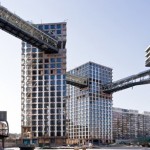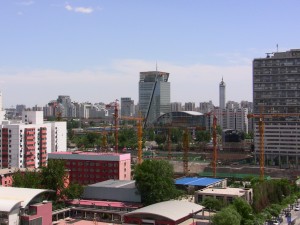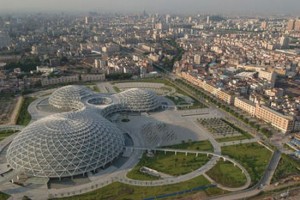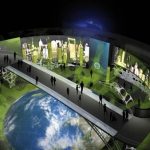Chinese Green Architecture (绿色建筑) Posted by Stephen on Aug 28, 2011 in Uncategorized
China, in its headlong attempt to modernize, is throwing up high rise skyscrapers at an unprecedented rate. Yet aside from all the cookie-cutter apartment complexes and standard office parks, a large number of “green” buildings are changing the skyline. Some look strange, others futuristic, but they all are part of China’s “Green Architecture” movement.
Considering that more than one third of global construction activities occur within Chinese borders it becomes highly likely that green architecture programs will continue sprout up and grow throughout the mainland. If successful, China is poised to become one of the premier locations for green design and “green architecture” globally, just by sheer volume of programs and projects alone.
The Numbers:
At least 10 percent of the country’s economic growth is supported by the consumption of construction materials. The amount of cement that China consumes annually is nearly 50 percent of the world total and the amount of steel consumed accounts for nearly 40 percent of the world total. Further, as a country with a per capita natural resources ratio much lower than the world average, China cannot afford to squander its resources on substandard construction practices that are inefficient in terms of energy and resource use. (I wrote a previous post on Recycling, demonstrating how efficient and green business can be).
In the recent 12th, Five-Year Plan, the Chinese government decreed that improvements to housing and building structures would become a priority. That being said, statistics show that complaints about the quality of housing increased from 37.1 percent in 2008 to 52.5 percent in 2009, which means that people are sick of substandard housing.
Plus all that construction waste creates pollution, both in air quality (particulate matter which is actually more detrimental to health that CO2 emissions) and in building waste products. Rubble from demolished buildings and refurbishment is 400 million tons a year, accounting for 30 to 40 percent of urban waste.
Green Architecture:
Green Architecture or 绿色建筑 (lǜ sè jiàn zhù) is the practice of creating structures and using processes that are environmentally responsible and resource-efficient throughout a building’s life-cycle: from positing to design, construction, operation, maintenance, renovation, and demolition. This practice expands and complements the classical building design concerns of economy, utility, durability, and comfort. Green architects and builders focus specifically on water and energy conservation, design efficiency, material efficiency, and waste reduction.
The practice blends a variety of energy efficient practices, coupled with the use of cheaper, recyclable resources throughout. Green architecture also looks to improve “human efficiency” and “maintenance operation” by creating large, open window spaces and work stations where employees/residents feel happier, promoting better worker/resident quality of life (if you spend time in one of these buildings you’ll see what I mean). Happy employees make good employees, raising worker efficiency. Further, air quality within these buildings is almost pristine, making them desirable locations for professionals (at a higher pay grade) to work in polluted Chinese cities.
Green buildings are usually LEED certified (Leadership in Engineering and Environmental Design), which uses a rating system based on how efficient the over building is (including building and function). LEED is intended to provide building owners and operators a concise framework for identifying and implementing practical and measurable green building design, construction, operations and maintenance solutions. The ratings are broken down into growing efficiency starting with a basic LEED certification, then building up from silver, gold and platinum.
While there is some debate to the overall costs of green building, most experts admit that green buildings are less than 2% more expensive than non-green counter parts in construction. However, in the long term, these building yield 10 times energy savings. In fact, studies have shown over a 20 year life period, some green buildings have yielded $53 to $71 per square foot back on investment. That’s making a building work for you!
Green Architecture in China:
In China, green architecture has really taken off, and like most things green, is quickly developing a market. If you had the opportunity to visit the Shanghai Expo, you probably noticed the emphasis on environmentalism and green business practices within many expo pavilions or 亭子 (tíng zi). Visit Beijing, Shanghai, Chongqing, Nanjing or any other large metropolis and you will undoubtedly come across one.
Aside from saving the environment, I personally find these buildings to be aesthetically gorgeous and amazing forms of function and design. These almost all glass facades which twist and turn in crazy geometric patterns are fun enough just to ride by on a bicycle. I liken it to “green art”.
Check out this slide show of China’s stunning Green Architecture.
Follow Steve on twitter: @seeitbelieveit

Build vocabulary, practice pronunciation, and more with Transparent Language Online. Available anytime, anywhere, on any device.
About the Author: Stephen
Writer and blogger for all things China related. Follow me on twitter: @seeitbelieveit -- My Background: Fluent Mandarin speaker with 3+ years working, living, studying and teaching throughout the mainland. Student of Kung Fu and avid photographer and documentarian.








Leave a comment: